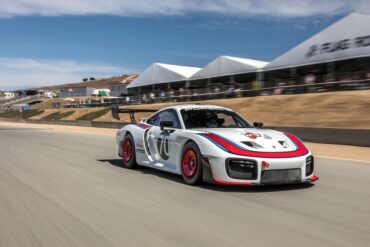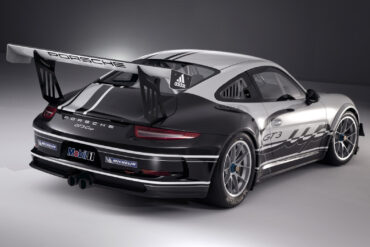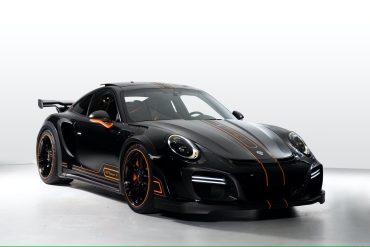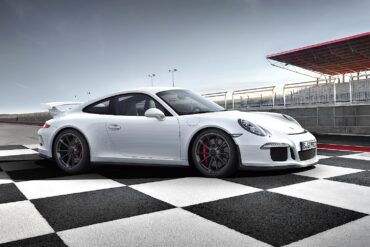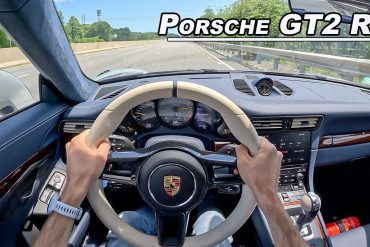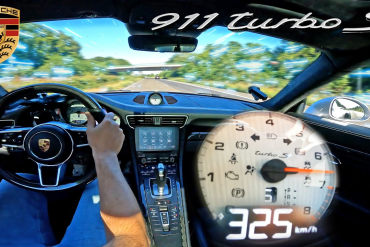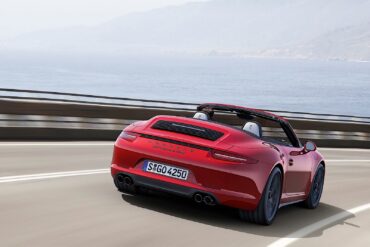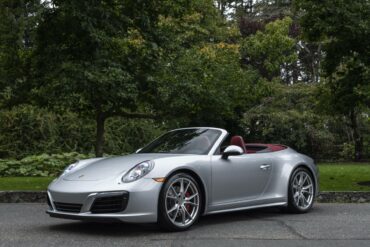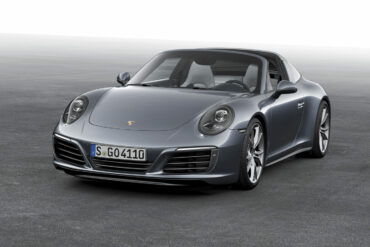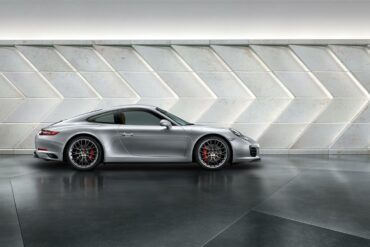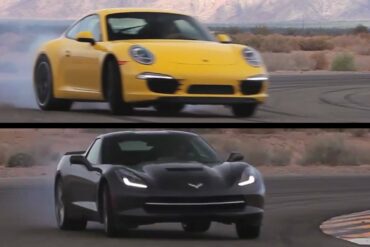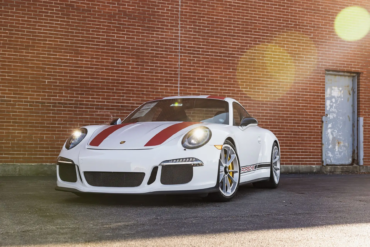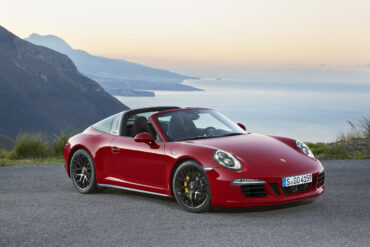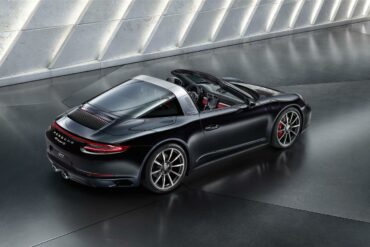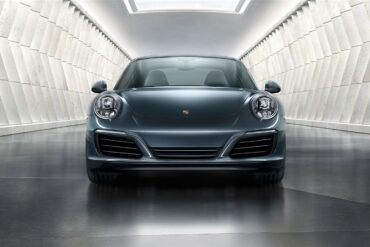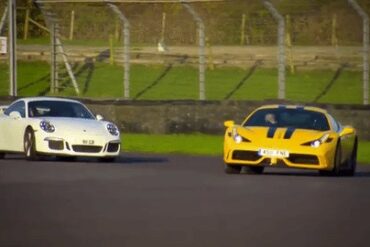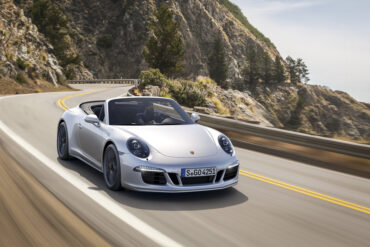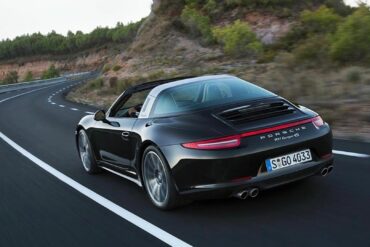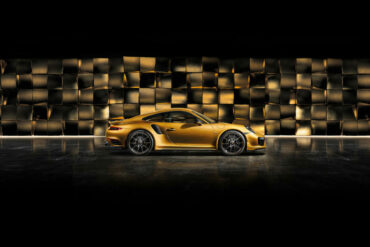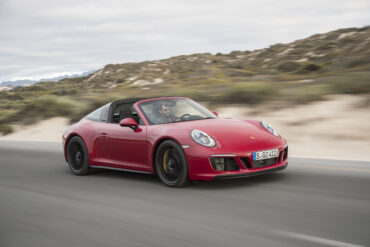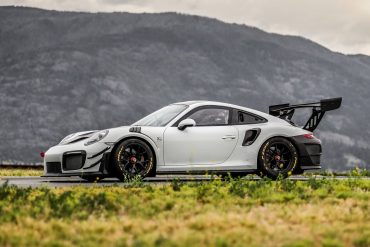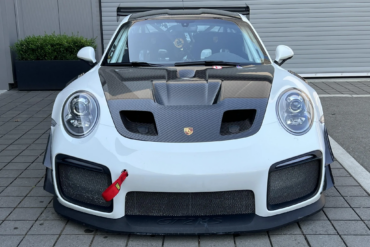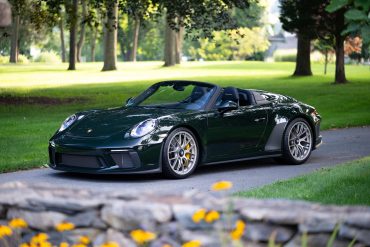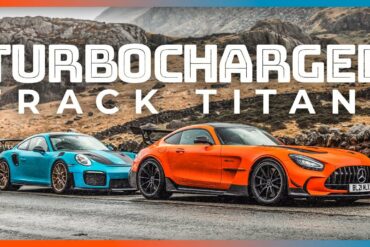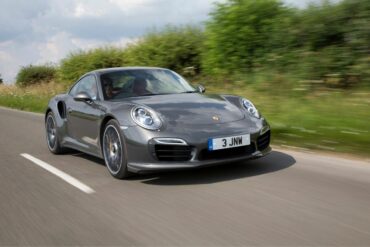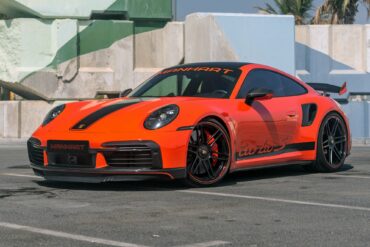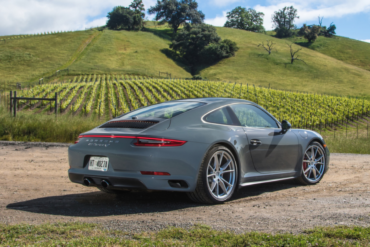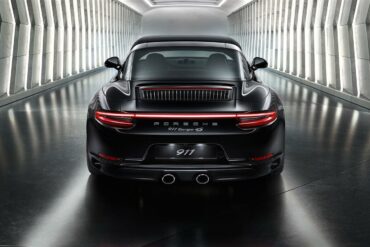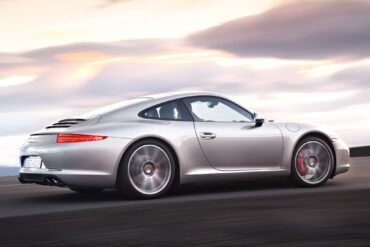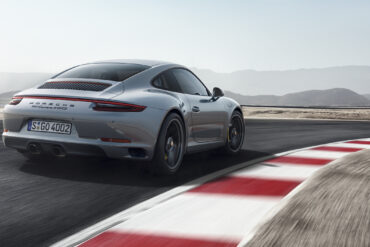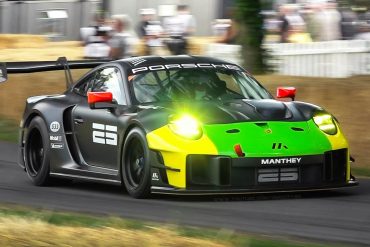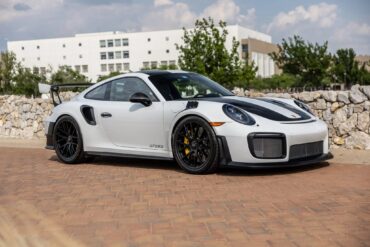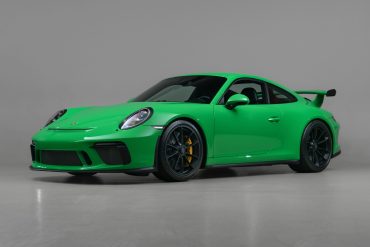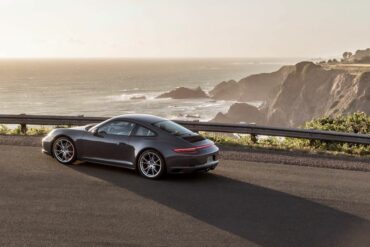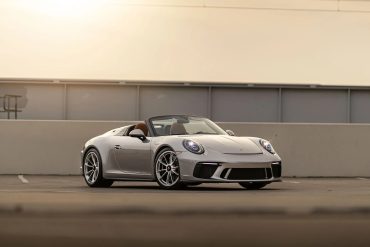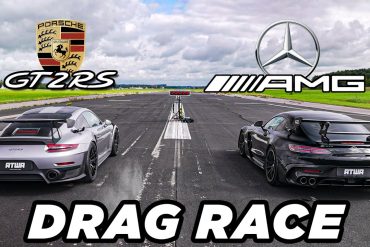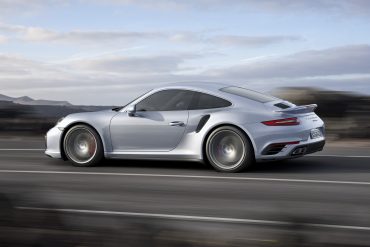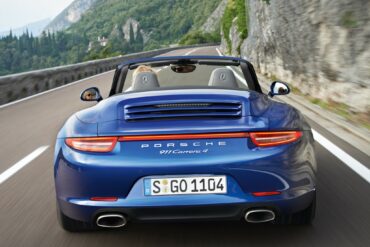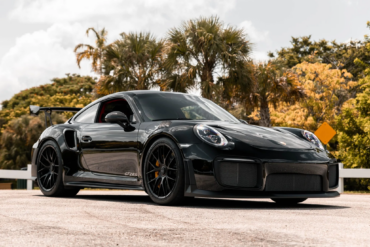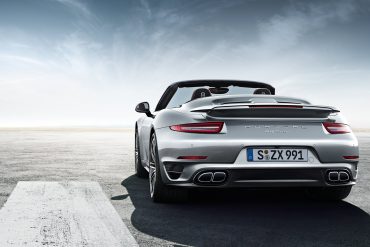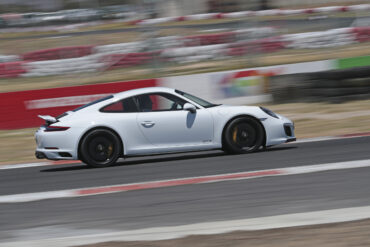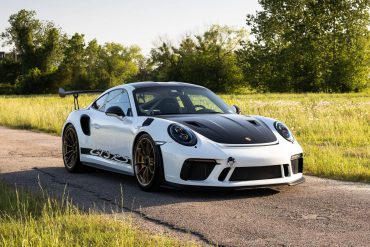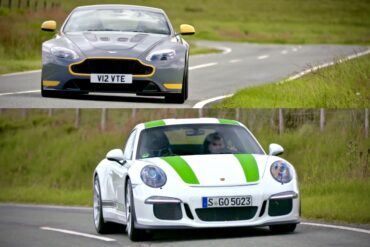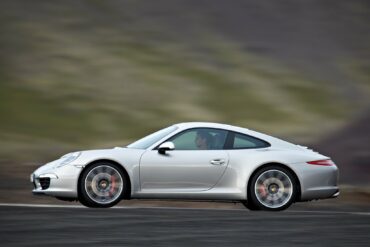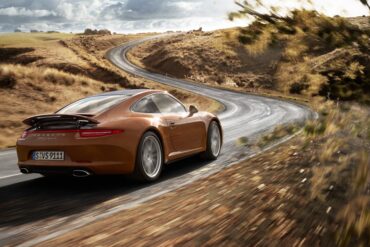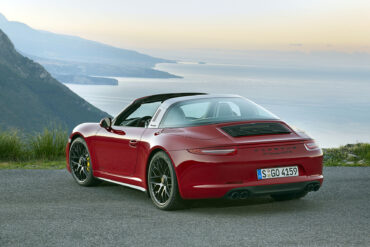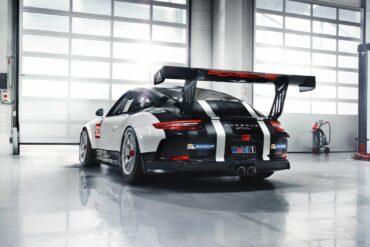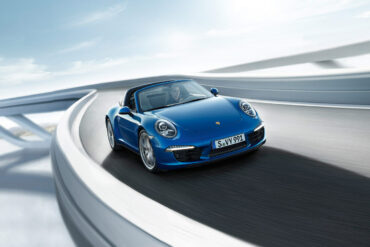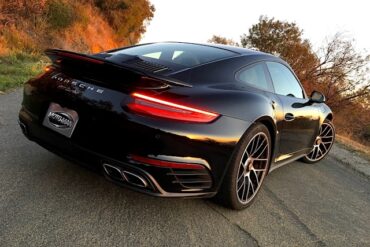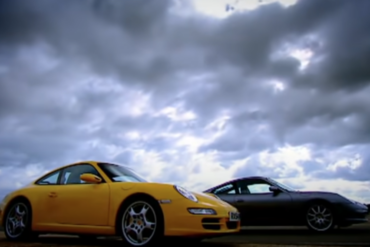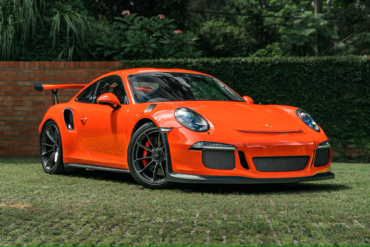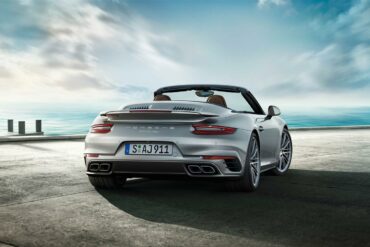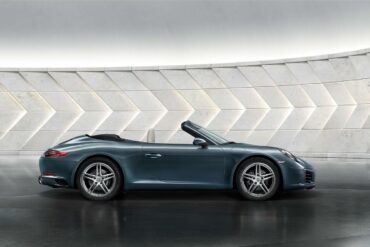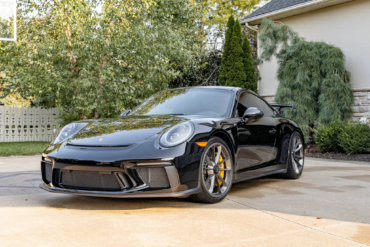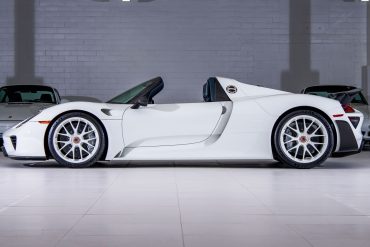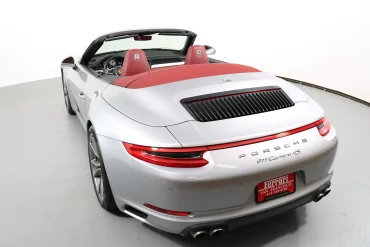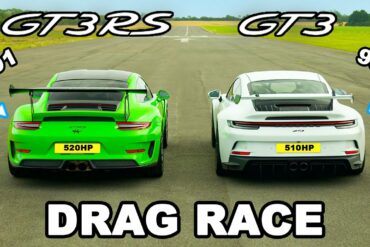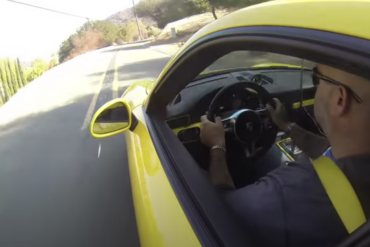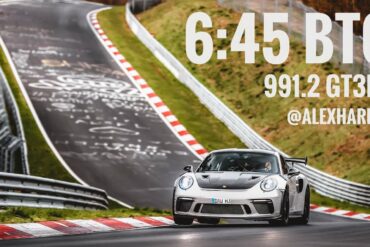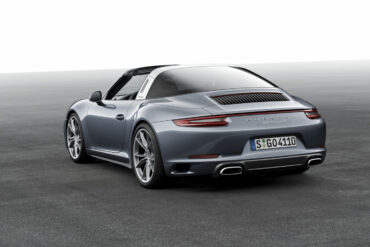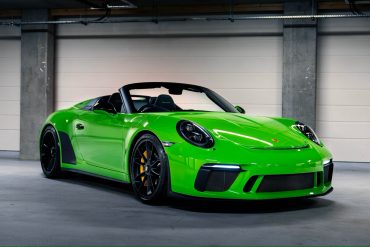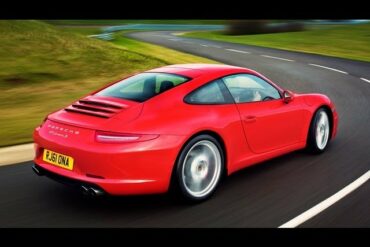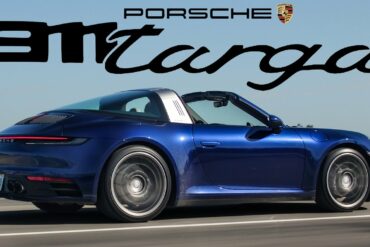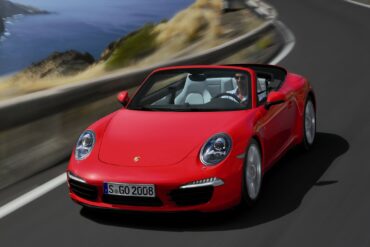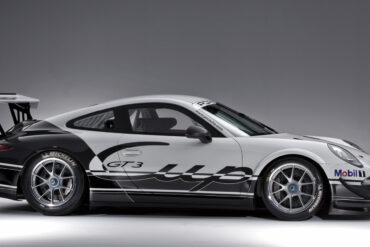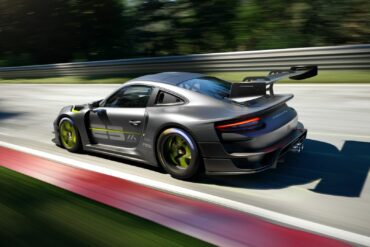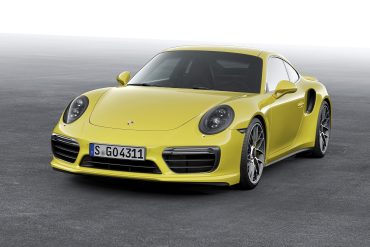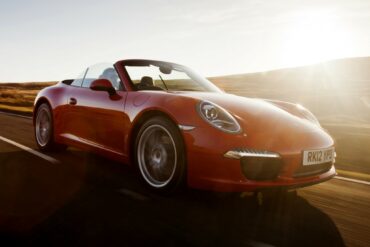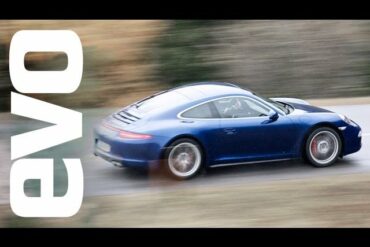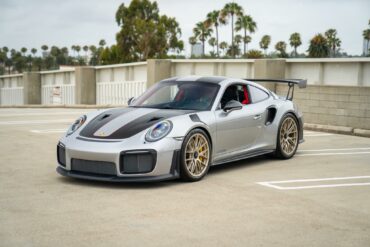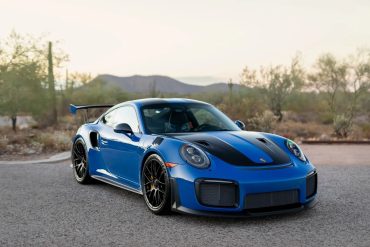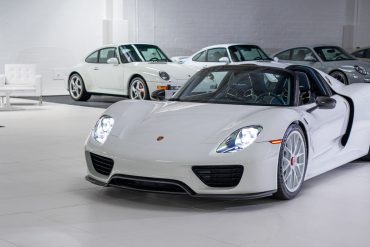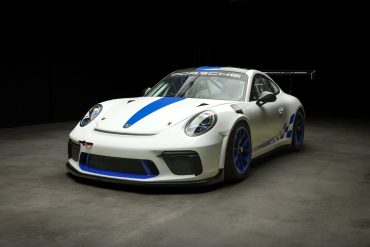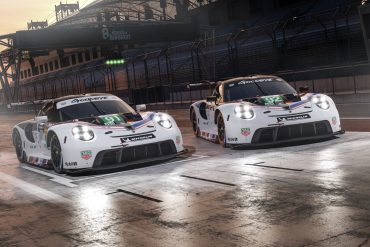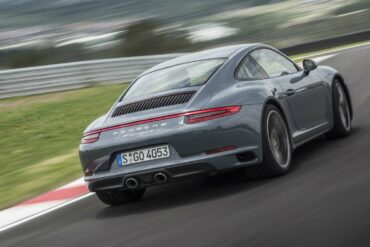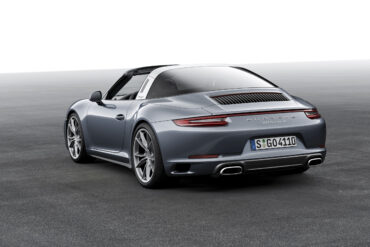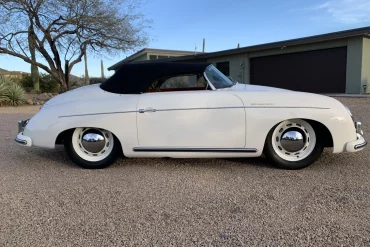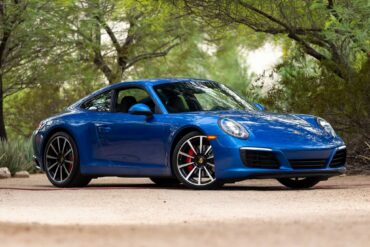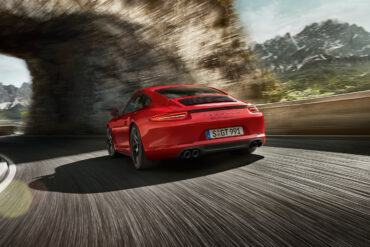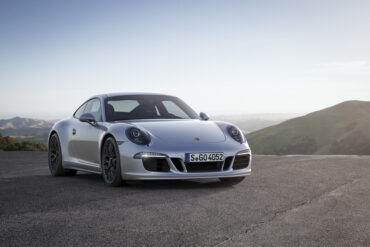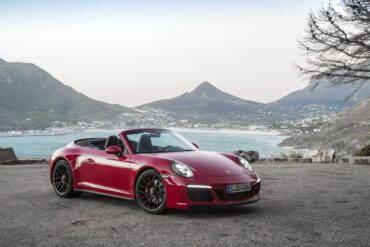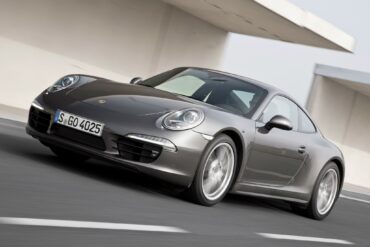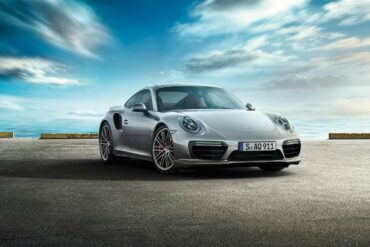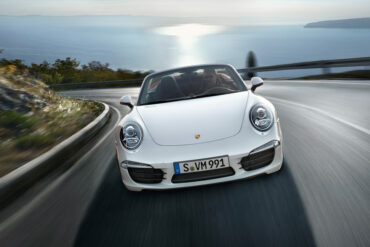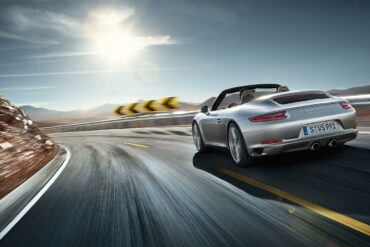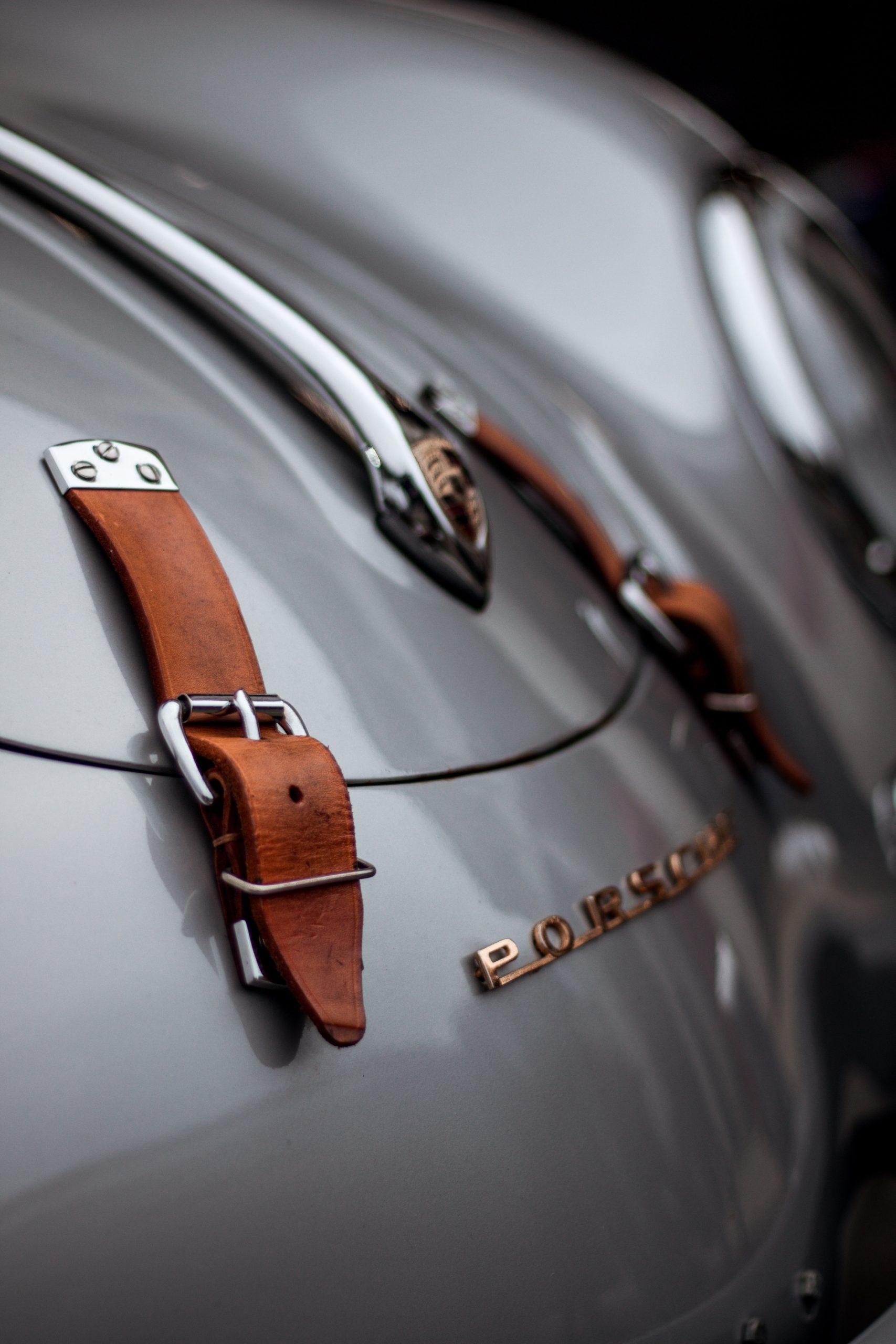The 935 tribute car was a non-street-legal collector's car built in a series of 77 cars. It was built from the 911 991.2 GT3 R racing car, fitted with the engine and transmission from the 911 991.2 GT2 RS street car and with the bodykit showing some design details from the 935 cars. The problem: it was not as powerful as the 1978 935 was with even smaller engine and the modern car is much heavier, so the power-to-weight ratio was almost 60% better 40 years earlier.
Porsche 911 (991)
The Type 991 911 series was the seventh generation of the iconic 911. The 991 generation models were unmistakably 911 in looks and design philosophy, but the 991 was really the ultimate evolution of Porsche 911s becoming highly technical, high quality and well built machines. Quality improved and the technology jump finally vaulted Porsche to the top of the automakers in terms of building the best cars on the planet. The Type 991 represented the most technically advanced 911 model to date and the 991 looked more powerful than any other 911 before – an effect that was heightened by the wider track and a stretched wheelbase. It also featured adaptive aerodynamics: the 911 was the first series sports car from Porsche to adopt this technology from the 918 Spyder hybrid super sports car. The 991.1 generation cars launched as MY 2012 cars. The 345hp 3.4 liter Carrera and 400hp 3.8 liter Carrera S launched first, in both Coupe and Cabriolet bodystyles and could be had with either rear and all-wheel drive drivetrains. The 991s all got electric power steering which took away some of the feel we were used to. The Carrera S got PASM standard (optional on the Carrera). The new Turbo (in coupe and cabriolet) came out in 2013, now with a whopping 512hp. See all of our Porsche 991 Research.
(2013-2016) Porsche 911 GT3 Cup (991.2) Technical Specifications Type Racing Car Built At Stuttgart, Germany Engine Flat-6 Position Rear, Longitudinal...
TechArt has transformed this 991.2-generation 911 Turbo S into their high-performance ‘GTStreet R’ specification. The car is coated in a...
2015 Porsche 911 GT3 (991) Technical Specifications type Series Production Car released at 2013 Geneva Motor Show built at Stuttgart, Germany...
The rear-engine, rear-wheel drive GT2 RS celebrated its official world premiere at the Goodwood Festival of Speed in the UK...
991.2 GT2 RS – Most Powerful 911 Driven The Porsche 911 GT2 RS, then. Take a Porsche 911, add a...
A race at the Nurburgring between a Porsche 991 GT3 RS, 992 GT3 MR, Cayman GT4 RS, and a BMW...
Porsche 911 Turbo S 992 v 991 Head To Head It’s the one you Porsche fanboys have been waiting for...
In a recent video shared by AutoTopNL on YouTube, we get to see a Porsche 991.2 Turbo S gets pushed...
Porsche 911 Carrera T Video Review In the Porsche 911 Carrera T Henry Catchpole revels in the delights of no...
2015 Porsche 911 Carrera GTS Cabriolet (991) Technical Specifications Engine layout Rear Engine Engine type Boxer-6 Cylinders 6 Valves per...
A new turbo flat-six engine is the headline news. Still super fast and surefooted all year round. The revised four-wheel-drive 911 makes the car's appeal on year-round, any-occasion usability even stronger. The 911 Carrera 4S receives a series of subtle styling updates as part of a reasonably comprehensive mid-life facelift. Included is a redesigned front bumper sporting active air ducts that open and close to channel air to the front-mounted radiators dependent on throttle load, revised headlights with altered internal graphics, larger exterior mirror housings and new door handles.
2017 Porsche 911 Targa 4 (991.2) Technical Specifications Engine Engine layout Rear Engine Engine type Boxer, twin-turbo Cylinders 6 Valves per...
2016 Porsche 911 Carrera S Coupe (991.2) Technical Specifications Engine Engine layout Rear Engine Engine type Boxer, twin-turbo Cylinders 6 Valves...
Chris Harris Compares the Corvette C7 v Porsche 991 Carrera S. On Track The Corvette costs the same as the optional...
Despite its limited numbers, the 2016 Porsche 911 R instantly become a hit among the most avid Porsche collectors and...
The 911 Targa 4 GTS isn't the fastest or best performing 911. It is heavier, softer and not as fast as every other GTS model. But we still love it. The Targa 4 GTS has amazing performance coupled with the sexiest body in the business. In GTS trim the Targa body looks even better. This is the car you get when you can only choose one 911 and you need it for fun weekends, daily driving and taking the wife out to a fancy restaurant. With 450 hp and 405 lb-ft from 2150 to 5000 rpm, it also has more than enough street performance than you could ever need. Buy one.
2016 Porsche 911 Targa 4S (991.2) Technical Specifications Engine Engine layout Rear Engine Engine type Boxer, twin-turbo Cylinders 6 Valves per...
2018 Porsche 911 Carrera Coupe (991.2) Technical Specifications Engine Engine layout Rear Engine Engine type Boxer, twin-turbo Cylinders 6 Valves per...
GT4 RS vs GT3 vs GT3RS When the opportunity arises to put the Porsche Cayman GT4 RS with the 991.2...
This video shows a head to head battle between the two of the best cars on the market today: the 458...
Like the rest of the GTS lineup, the 991.1 Carrera GTS Cabriolet is essentially a kind of 991 Greatest Hits package, hand-picking some of the more desirable components and options from the 911 range. It gets Porsche's PASM (Porsche Active Suspension Management), Sport Chrono with Sport Plus, the Sport Exhaust system, and a ride height that's roughly four-tenths of an inch lower than non-GTS models. It also gets a version of Porsche's 3.8-liter flat-six with 430 hp, hits 60 mph in 4.0 seconds equipped with the PDK (4.4 to 60 mph for the manual), and tops out at 189 mph.
2014 – 2015 Porsche 911 Targa 4S Pictures & Gallery ...
Check out this really incredible review on a heavily modded 2015 Porsche 911 Turbo S 991.1 with upgraded turbochargers and...
2018 – 2019 Porsche 911 Turbo S Exclusive (991.2) Pictures & Gallery ...
2019 Porsche 911 Targa 4 GTS (991.2) Technical Specifications Engine Engine layout Rear Engine Engine type Boxer, twin-turbo Cylinders 6 Valves...
The 911 GT2 RS Clubsport made its debut alongside the new 992-generation 911 at the 2018 Los Angeles Auto Show,...
2019 was the last model year for the seventh-generation 911 (991) and for that Porsche introduced the GT2 RS Clubsport....
The 2019 Porsche 911 Speedster is the beneficiary of Stuttgart’s latest fixings, while also serving as a throwback to the...
In a recent video, YouTube channel Supercar Driver compare a Porsche 911 GT2 RS against Mercedes-AMG GT Black Series. These...
Porsche 911 Spare Parts Catalogs (991, 2012 – 2019 Model Year) These official Porsche PET Diagrams and codes for the...
Without a doubt, the Porsche 911 Turbo is one of the most legendary and recognizable sports car models in the...
2019 Porsche 911 Carrera 4S (991.2) Technical Specifications Engine layout Rear Engine Engine type Boxer, twin-turbo Cylinders 6 Valves per cylinder...
2018 Porsche 911 Targa 4S (991.2) Technical Specifications Engine Engine layout Rear Engine Engine type Boxer, twin-turbo Cylinders 6 Valves per...
2012 Porsche 911 Carrera S Coupe (991) Technical Specifications Engine Type Flat 6 Induction Normally-aspirated Cooling Water-cooled Valvetrain Four overhead camshafts,...
2019 Porsche 911 Carrera 4 GTS (991.2) Technical Specifications Engine Engine layout Rear Engine Engine type Boxer, twin-turbo Cylinders 6 Valves...
The 2017 Porsche 911 Turbo S GTStreet R by with its carbon-fiber body, huge double-decked rear wing, GT3 RS-style wheelarch...
Watch this video by 19Bozzy92 YouTube channel featuring a Porsche 911 GT2 RS Clubsport 25, a special limited edition model...
The debut of the Porsche 911 GT2 RS took place during the 997 generation in 2010 and received exceptional acclaim....
Head to Head Mercedes-AMG GT C vs Porsche 911 Carrera T For the road, the GT C is the best...
The 991.2 generation of Porsche’s 911 GT3 marked a significant improvement over its predecessor, incorporating several desirable changes. Responding to...
2016 Porsche 911 Carrera 4S (991.2) Technical Specifications Engine layout Rear Engine Engine type Boxer, twin-turbo Cylinders 6 Valves per cylinder...
Since its debut in 1954, Porsche has reintroduced the Speedster model several times, the latest being the 991 iteration. The...
With the Turbo S, the PDCC Porsche Dynamic Chassis Control hydraulic roll bars came as standard. The PCCB Porsche Ceramic Composite Brakes had been standard on the Turbo S already since the 996 generation. New options included the radar-based lane change assist and a lift system for the front axle (increased ground clearance by 1.6″/40 mm). The PCM now had a multi-touch screen like in the facelifted 991 Carrera. Routes and places could be visualized with 360-degree images and satellite images. Engine gets more horsepower too, now with 572 bhp and 553 ft lbs of torque.
Porsche and Mercedes-AMG have been engaged in a captivating rivalry over the past few years, each striving to create the...
2017 – 2019 Porsche 911 Turbo (991.2) Pictures & Gallery ...
2015 Porsche 911 Carrera 4 Cabriolet (991) Technical Specifications Engine Type Flat 6 Induction Normally-aspirated Cooling Water-cooled Valvetrain Four overhead camshafts,...
Here’s what happens when you let a rally driver slide behind the wheel of a Porsche GT3 RS by Manthey...
The 991-generation GT2 RS has been called as the pinnacle of the German automaker’s lineup of high-performance road cars. Only...
2015 Porsche 911 Turbo Cabriolet (991) Technical Specifications Engine layout Rear Engine Engine type Twin Turbo Boxer w/ VTG Cylinders 6...
2017 Porsche 911 Carrera 4 GTS (991.2) Technical Specifications Engine Engine layout Rear Engine Engine type Boxer, twin-turbo Cylinders 6 Valves...
In 2018, Porsche introduced the facelifted 991.2 version of the 911 GT3 RS. This updated model featured redesigned aerodynamic bodywork...
991.2 GT2 RS – Most Powerful 911 Driven Porsche‘s Most Powerful 911 ever!! The Legendary GT2 RS! When a 911 Turbo...
Aston V12 Vantage S Vs Porsche 911 R The Porsche 911 R has 493bhp from a 4-litre naturally aspirated flat-six...
2014 Porsche 911 Carrera S Coupe (991) Technical Specifications Engine Type Flat 6 Induction Normally-aspirated Cooling Water-cooled Valvetrain Four overhead camshafts,...
2014 Porsche 911 Carrera 4 Coupe (991) Technical Specifications Engine Type Flat 6 Induction Normally-aspirated Cooling Water-cooled Valvetrain Four overhead camshafts,...
First Europe, then North America The 991.1 GTS was the second 911 offered as a GTS sub-brand. The first was...
(2016-2020) Porsche 911 GT3 Cup (991.2) Technical Specifications Concept Single-seater production-based race car Base model: 911 GT3 Engine Aluminium six-cylinder...
2014 – 2015 Porsche 911 Targa 4 Pictures & Gallery ...
MotoManTV Review of the 991.2 Turbo After fitting all base 991s with turbos, Porsche has gone through and updated the...
Jeremy takes the Porsche 911 Carrera S out for a spin Jeremy takes the Porsche 911 Carrera S out for...
Don’t miss your chance to own a low mileage and almost-new example of a 2016 Porsche 911 (991.1) GT3 RS...
2018 Porsche 911 Turbo Cabriolet (991.2) Technical Specifications Engine Engine layout Rear Engine Engine type Boxer, twin-turbo Cylinders 6 Valves per...
2016 Porsche 911 Carrera Cabriolet (991.2) Technical Specifications Engine Engine layout Rear Engine Engine type Boxer, twin-turbo Cylinders 6 Valves per...
Acquired by the seller in March 2019, this 991.2-generation Porsche 911 GT3 features a host of desirable options like its...
As the Porsche market continues its strong trajectory, RM Sotheby’s is thrilled to unveil “The White Collection” auction—a unique gathering...
2017 Porsche 911 Carrera 4S Cabriolet (991.2) Technical Specifications Engine layout Rear Engine Engine type Boxer, twin-turbo Cylinders 6 Valves per...
Two of our favorites duke it out...
TheSmokingTire Review of the 991 Porsche 911 Carrera S Matt takes a spirited drive through the canyons in the 2014...
Watch as a 991.2 Porsche 911 GT3 RS (driven by Alex Hardt) completes a full lap around Nordschleife of the...
2019 Porsche 911 Targa 4 (991.2) Technical Specifications Engine Engine layout Rear Engine Engine type Boxer, twin-turbo Cylinders 6 Valves per...
A stock Porsche 911 Turbo S, particularly from the 991-generation, is already an impressive vehicle. With a 560-horsepower 3.8L twin-turbo...
Celebrating their 70th anniversary, Porsche unveiled the Type 991.2 Speedster concept at the 2018 Paris Motor Show, marking a significant...
Autocar Reviews the New 991.1 Carrera S The new Porsche 911 Carrera S (991) is the most important new sports...
Make no mistake that the Speedster is an absolutely fitting conclusion to the 991-generation. The Porsche 911 Speedster is an ingenious amalgamation of the latest technologies on offer, and the more simple ingredients that have been a principle of driving enjoyment since the invention of automobiles. A 502-horsepower engine, without turbochargers. A modern transmission, with just one clutch. A state-of-the-art suspension and chassis, with an unsullied purity. The list goes on. Perhaps the only drawback is that the Speedster’s rarity and price.
2021 Porsche 911 Targa Review 2021 Porsche 911 Targa review by The Straight Pipes. The 992 Porsche 911 Targa is...
2012 – 2015 Porsche 911 Carrera S Cabriolet Pictures & Gallery ...
2013 – 2016 Porsche 911 GT3 Cup (991) Pictures & Gallery...
2021 Porsche 911 GT2 RS Clubsport 25 (991.2) Technical Specifications What drives us? The next victory. Even after 25 years,...
2017 – 2019 Porsche 911 Turbo S (991.2) Pictures & Gallery ...
2012 Porsche 911 Carrera Cabriolet (991) Technical Specifications Engine Type Flat 6 Induction Normally-aspirated Cooling Water-cooled Valvetrain Four overhead camshafts, four...
Sporty, stylish, and a super-fast all-weather grand tourer is how would you like to best describe this 2015 Porsche 911...
2018 Porsche 911 Turbo S Exclusive (991.2) Technical Specifications Engine Engine layout Rear Engine Engine type Boxer, twin-turbo Cylinders 6 Valves...
Henry Catchpole Drives the new 991 Carrera 4S evo’s Henry Catchpole takes the new 991 Carrera 4S, the latest four-wheel-drive...
We’ve got some good news for you, as we’ve found a bargain for a Porsche! Currently, a 2018 Porsche 991...
The Porsche 911 GT2 RS made its debut with the 997 generation in 2010 and received widespread acclaim. In 2018,...
You already read about our preview of The White Collection auction here on Stuttcars. Fifty-five Porsches, mostly in white, with...
Built as the second example in a limited production series of only five units for the year 2018, this GT3...
At the FIA World Endurance Championship WEC, two 911 RSR by the Porsche GT Team will be saying farewell to...
2019 Porsche 911 Carrera 4 Coupe (991.2) Technical Specifications Engine layout Rear Engine Engine type Boxer, twin-turbo Cylinders 6 Valves per...
2016 – 2019 Porsche 911 Targa 4 (991.2) Pictures & Gallery...
There are two interesting Porsches on offer at Bring a Trailer today: a 1955 Porsche 356 1500S Speedster coming from...
PCarMarket is currently auctioning a 2017 Porsche 991.2 Carrera S painted in Sapphire Blue Metallic over a black leather interior....
2015 – 2016 Porsche 911 Carrera GTS (991) Pictures & Gallery ...
More aggressive looks, significant extra power, and highly desirable options. This is the perfect all-round 911. In manual, there is nothing that feels as complete. Some of the technical ingredients that generate even more driving dynamics and driving fun: 430 hp (316 kW) power, the Sport Chrono package and the PASM active damper system which lowers the car's ride height by ten millimetres. The extra punch of the 430-hp engine pushes the 911 Carrera GTS coupe up to 190 mph in rear-wheel-drive/manual-transmission configuration, 2 mph higher than the 400-hp Carrera S.
Porsche really has hit its brief with the turbocharged Carrera GTS Cabriolet. It is hugely capable on the road, easy to live with on a daily basis, and come the weekend, it’s massively fast on track. For the money, and for drivers who really want just a little more 911, but without the mind-bending speed of a Turbo or uncompromising nature of a GT3, then this is the car for you. It also looks unique and has enough of its own style that it it feels special both on the outside and inside.
2013 – 2015 Porsche 911 Carrera 4 Pictures & Gallery ...
At the heart of the 991.2 911 Turbo is a twin-turbocharged flat-six with 540 horsepower and 523 pound-feet of torque. That’s a meaningful 20 more horses than the 991.1 Turbo. Improvements that come from increases in boost and fuel-injection pressures. Rounding the skidpad, the Turbo posts 1.02 g’s relatively easily. The wide P Zeros in back and the standard four-wheel steering conspire to hide the fact that 62 percent of the Turbo’s 3656 pounds sits over the rear wheels. With sport-plus selected, the 991.2 Turbo hits a 1.0-second run to 30 mph and a 2.6-second zero-to-60 time.
2013 Porsche 911 Carrera S Cabriolet (991) Technical Specifications Engine Type Flat 6 Induction Normally-aspirated Cooling Water-cooled Valvetrain Four overhead camshafts,...
2018 Porsche 911 Carrera S Cabriolet (991.2) Technical Specifications Engine Engine layout Rear Engine Engine type Boxer, twin-turbo Cylinders 6 Valves...


